Research on the Growth Mechanism of PM2.5 in Central and Eastern China during Autumn and Winter from 2013–2020
Abstract
:1. Introduction
2. Materials and Methods
3. Results and Discussion
3.1. Average Distribution of PM2.5 in Autumn and Winter of China from 2013 to 2020
3.2. Classification of PM2.5 Growth Periods in Central and Eastern China form 2013 to 2020
3.3. Size Distribution
3.4. Chemical Composition
4. Conclusions
Author Contributions
Funding
Institutional Review Board Statement
Informed Consent Statement
Data Availability Statement
Acknowledgments
Conflicts of Interest
Appendix A

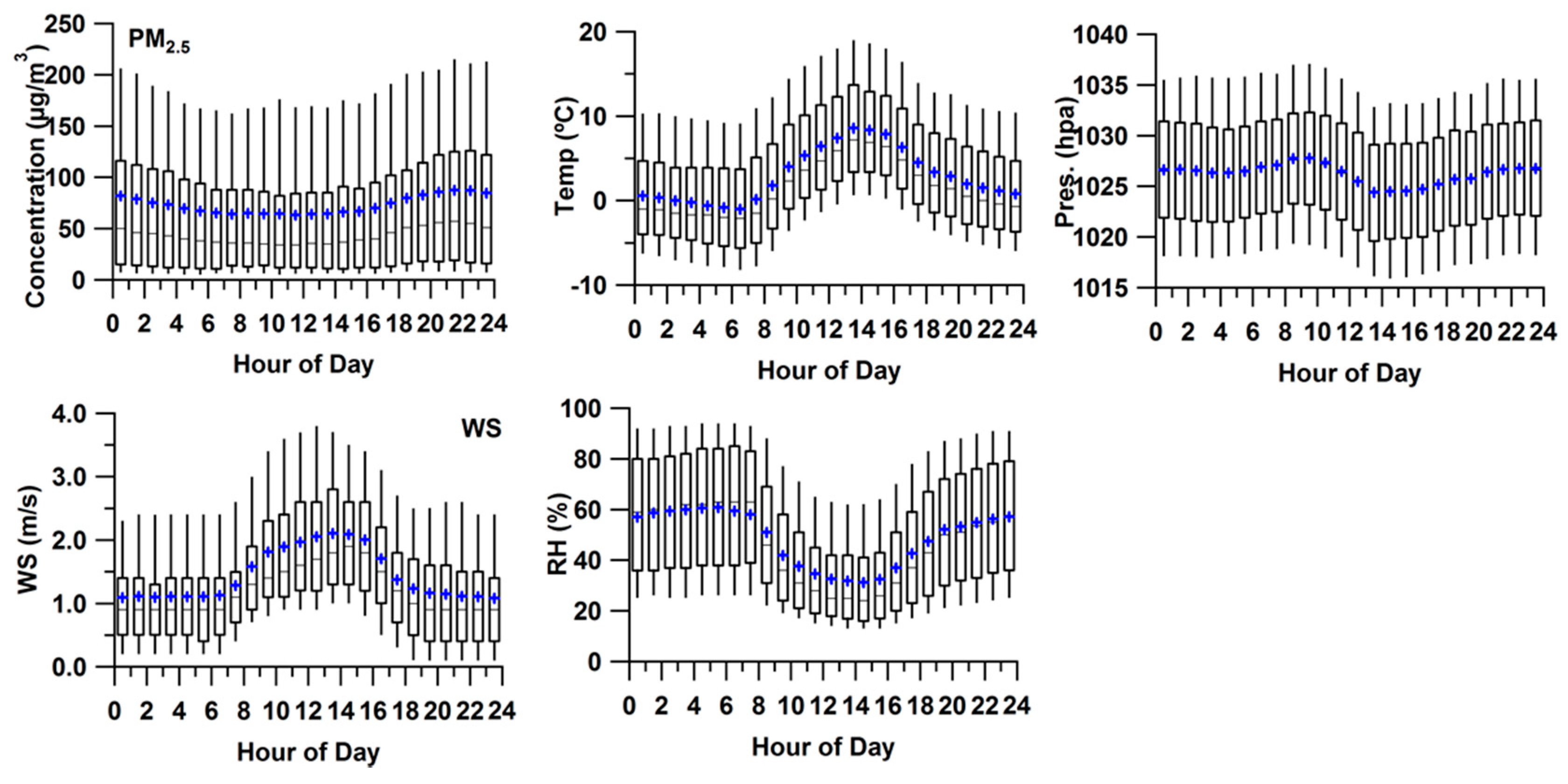
References
- Liu, C.; Guo, J.; Zhang, B.; Zhang, H.; Guan, P.; Xu, R. A Reliability Assessment of the NCEP/FNL Reanalysis Data in Depicting Key Meteorological Factors on Clean Days and Polluted Days in Beijing. Atmosphere 2021, 12, 481. [Google Scholar] [CrossRef]
- Fang, C.; Tan, X.; Zhong, Y.; Wang, J. Research on the Temporal and Spatial Characteristics of Air Pollutants in Sichuan Basin. Atmosphere 2021, 12, 1504. [Google Scholar] [CrossRef]
- Cheng, Z.; Wang, S.X.; Fu, X.; Watson, J.G.; Jiang, J.; Fu, Q.; Chen, C.; Xu, B.; Yu, J.; Chow, J.; et al. Impact of biomass burning on haze pollution in the Yangtze River delta, China: A case study in summer 2011. Atmos. Chem. Phys. 2014, 14, 4573–4585. [Google Scholar] [CrossRef] [Green Version]
- Wang, H.; Li, J. Dual effects of environmental regulation on PM2.5 pollution: Evidence from 280 cities in China. Environ. Sci. Pollut. Res. 2021, 28, 47213–47226. [Google Scholar] [CrossRef] [PubMed]
- Zhang, Q.H.; Zhang, J.P.; Xue, H.W. The challenge of improving visibility in Beijing. Atmos. Chem. Phys. 2010, 10, 7821–7827. [Google Scholar] [CrossRef] [Green Version]
- Fu, H.; Chen, J. Formation, features and controlling strategies of severe haze-fog pollutions in China. Sci. Total Environ. 2017, 578, 121–138. [Google Scholar] [CrossRef] [PubMed]
- Zhang, L.; Sun, J.Y.; Shen, X.J.; Zhang, Y.M.; Che, H.; Ma, Q.L.; Zhang, Y.W.; Zhang, X.Y.; Ogren, J.A. Observations of relative humidity effects on aerosol light scattering in the Yangtze River Delta of China. Atmos. Chem. Phys. 2015, 15, 8439–8454. [Google Scholar] [CrossRef] [Green Version]
- Liu, X.H.; Zhu, B.; Kang, H.Q.; Hou, X.W.; Gao, J.H. Stable and transport indices applied to winter air pollution over the Yangtze River Delta, China. Environ. Pollut. 2020, 272, 115954. [Google Scholar] [CrossRef]
- Tie, X.; Huang, R.J.; Cao, J.; Zhang, Q.; Cheng, Y.; Su, H. Severe Pollution in China Amplified by Atmospheric Moisture. Sci. Rep. 2017, 7, 15760. [Google Scholar] [CrossRef]
- Xu, W.Q.; Chen, C.; Qiu, Y.M.; Li, Y.; Sun, Y.L. Organic aerosol volatility and viscosity in the North China Plain: Contrast between summer and winter. Atmos. Chem. Phys. 2021, 21, 5463–5476. [Google Scholar] [CrossRef]
- Liu, L.; Zhang, X.; Zhong, J.; Wang, J.; Yang, Y. The ‘two-way feedback mechanism’ between unfavorable meteorological conditions and cumulative PM2.5 mass existing in polluted areas south of Beijing. Atmos. Environ. 2019, 208, 1–9. [Google Scholar] [CrossRef]
- Li, J.; Han, Z. A modeling study of severe winter haze events in Beijing and its neighboring regions. Atmos. Res. 2016, 170, 87–97. [Google Scholar] [CrossRef]
- Zhong, J.; Zhang, X.; Wang, Y. Reflections on the threshold for PM2.5 explosive growth in the cumulative stage of winter heavy aerosol pollution episodes (HPEs) in Beijing. Tellus B Chem. Phys. Meteorol. 2019, 71, 1528134. [Google Scholar] [CrossRef] [Green Version]
- Zhang, X.Y.; Xu, X.D.; Ding, Y.H.; Liu, Y.J.; Zhang, H.D.; Wang, Y.Q.; Zhong, J.T. The impact of meteorological changes from 2013 to 2017 on PM2.5 mass reduction in key regions in China. Sci. China Earth Sci. 2019, 4, 483–500. (In Chinese) [Google Scholar] [CrossRef]
- Lei, L.; Xie, C.H.; Wang, D.W.; He, Y.; Sun, Y.L. Fine particle characterization in a coastal city in China: Composition, sources, and impacts of industrial emissions. Atmos. Chem. Phys. 2020, 20, 2877–2890. [Google Scholar] [CrossRef] [Green Version]
- Quan, J.; Liu, Q.; Li, X.; Gao, Y.; Jia, X.; Sheng, J.; Liu, Y. Effect of heterogeneous aqueous reactions on the secondary formation of inorganic aerosols during haze events. Atmos. Environ. 2015, 122, 306–312. [Google Scholar] [CrossRef] [Green Version]
- Wang, D.; Zhou, B.; Fu, Q.; Zhao, Q.; Qi, Z.; Chen, J.; Xin, Y.; Duan, Y.; Li, J. Intense secondary aerosol formation due to strong atmospheric photochemical reactions in summer: Observations at a rural site in eastern Yangtze River Delta of China. Sci. Total Environ. 2016, 571, 1454–1466. [Google Scholar] [CrossRef] [PubMed]
- Yu, Q.; Chen, J.; Qin, W.; Cheng, S.; Zhang, Y.; Ahmad, M.; Ouyang, W. Characteristics and secondary formation of water-soluble organic acids in PM1, PM2.5 and PM10 in Beijing during haze episodes. Sci. Total Environ. 2019, 669, 175–184. [Google Scholar] [CrossRef] [PubMed]
- China State Council. Action Plan on Prevention and Control of Air Pollution. China State Council, Beijing, China. 2013. Available online: http://www.gov.cn/zwgk/2013-09/12/content_2486773.htm (accessed on 1 January 2018).
- Sulaymon, I.D.; Zhang, Y.; Hu, J.; Hopke, P.K.; Zhang, Y.; Zhao, B.; Xing, J.; Li, L.; Mei, X. Evaluation of regional transport of PM2.5 during severe atmospheric pollution episodes in the western Yangtze River Delta, China. J. Environ. Manag. 2021, 293, 112827. [Google Scholar] [CrossRef]
- Ning, G.; Wang, S.; Ma, M.; Ni, C.; Shang, Z.; Wang, J.; Li, J. Characteristics of air pollution in different zones of Sichuan Basin, China. Sci. Total Environ. 2018, 612, 975–984. [Google Scholar] [CrossRef]
- Cao, J.; Cui, L. Current Status, Characteristics and Causes of Particulate Air Pollution in the Fenwei Plain, China: A Review. J. Geophys. Res. Atmos. 2021, 126, e2020JD034472. [Google Scholar] [CrossRef]
- Li, Z.; Lei, L.; Li, Y.; Chen, C.; Wang, Q.; Zhou, W.; Sun, J.; Xie, C.; Sun, Y. Aerosol characterization in a city in central China plain and implications for emission control. J. Environ. Sci. 2021, 104, 242–252. [Google Scholar] [CrossRef]
- Zheng, G.J.; Duan, F.K.; Su, H.; Ma, Y.L.; Cheng, Y.; Zheng, B.; Zhang, Q.; Huang, T.; Kimoto, T.; Chang, D.; et al. Exploring the severe winter haze in Beijing: The impact of synoptic weather, regional transport and heterogeneous reactions. Atmos. Chem. Phys. 2015, 15, 2969–2983. [Google Scholar] [CrossRef] [Green Version]
- Wang, Z.F.; Li, J.; Wang, Z.; Yang, W.Y.; Tang, X.; Ge, B.Z.; Yan, P.Z. Modeling study of regional severe hazes over mid-eastern China in January 2013 and its implications on pollution prevention and control. Sci. China Earth Sci. 2014, 57, 3–13. [Google Scholar] [CrossRef]
- Zhong, J.T.; Zhang, X.Y.; Dong, Y.S.; Wang, Y.Q. Feedback effects of boundary-layer meteorological factors on cumulative explosive growth of PM2.5 during winter heavy pollution episodes in Beijing from 2013 to 2016. Atmos. Chem. Phys. 2018, 18, 247–258. [Google Scholar] [CrossRef] [Green Version]
- Sun, Y.; Lei, L.; Zhou, W.; Chen, C.; Worsnop, D.R. A chemical cocktail during the COVID-19 outbreak in Beijing, China: Insights from six-year aerosol particle composition measurements during the Chinese New Year holiday. Sci. Total Environ. 2020, 742, 140739. [Google Scholar] [CrossRef]
- Sun, Y.; Wang, Z.; Dong, H.; Yang, T.; Li, J.; Pan, X.; Chen, P.; Jayne, J.T. Characterization of summer organic and inorganic aerosols in Beijing, China with an Aerosol Chemical Speciation Monitor. Atmos. Environ. 2012, 51, 250–259. [Google Scholar] [CrossRef]
- Ng, N.L.; Canagaratna, M.R.; Jimenez, J.L.; Chhabra, P.S.; Seinfeld, J.H.; Worsnop, D.R. Changes in organic aerosol composition with aging inferred from aerosol mass spectra. Atmos. Chem. Phys. 2011, 11, 6465–6474. [Google Scholar] [CrossRef] [Green Version]
- Wei, J.; Li, Z.; Lyapustin, A.; Sun, L.; Peng, Y.; Xue, W.; Su, T.; Cribb, M. Reconstructing 1-km-resolution high-quality PM2.5 data records from 2000 to 2018 in China: Spatiotemporal variations and policy implications. Remote Sens. Environ. 2021, 252, 112136. [Google Scholar] [CrossRef]
- Nozaki, K.Y. Mixing Depth Model Vsing Hourly Surface Observations; Report 7053; USAF Environmental Technical Applications Center: Patrick Space Force Base, FL, USA, 1973. [Google Scholar]
- Paatero, P.; Tapper, U. Positive Matrix Factorization: A non-negative factor model with optimal utilization of error estimates of data values. Environmetrics 1994, 5, 111–126. [Google Scholar] [CrossRef]
- Ulbrich, I.M.; Canagaratna, M.R.; Zhang, Q.; Worsnop, D.R.; Jimenez, J.L. Interpretation of organic components from Positive Matrix Factorization of aerosol mass spectrometric data. Atmos. Chem. Phys. 2009, 9, 2891–2918. [Google Scholar] [CrossRef] [Green Version]
- DeCarlo, P.F.; Ulbrich, I.M.; Crounse, J.; de Foy, B.; Dunlea, E.J.; Aiken, A.C.; Knapp, D.; Weinheimer, A.J.; Campos, T.; Wennberg, P.O.; et al. Investigation of the sources and processing of organic aerosol over the Central Mexican Plateau from aircraft measurements during MILAGRO. Atmos. Chem. Phys. 2010, 10, 5257–5280. [Google Scholar] [CrossRef] [Green Version]
- Sun, Y.L.; Wang, Z.F.; Wild, O.; Xu, W.Q.; Chen, C.; Fu, P.Q.; Du, W.; Zhou, L.B. “APEC Blue”: Secondary Aerosol Reductions from Emission Controls in Beijing. Sci. Rep. 2016, 6, 20668. [Google Scholar] [CrossRef] [PubMed] [Green Version]
- Zhao, J.; Du, W.; Zhang, Y.J.; Wang, Q.Q.; Chen, C.; Xu, W.Q.; Han, T.T.; Wang, Y.; Fu, P.Q.; Wang, Z.F. Insights into aerosol chemistry during the 2015 China Victory Day parade: Results from simultaneous measurements at ground level and 260 m in Beijing. Atmos. Chem. Phys. 2017, 17, 3215–3232. [Google Scholar] [CrossRef] [Green Version]
- Ansari, T.U.; Wild, O.; Li, J.; Yang, T.; Xu, W.Q.; Sun, Y.L.; Wang, Z.F. Effectiveness of short-term air quality emission controls: A high-resolution model study of Beijing during the Asia-Pacific Economic Cooperation (APEC) summit period. Atmos. Chem. Phys. 2019, 19, 8651–8668. [Google Scholar] [CrossRef] [Green Version]
- Hussein, T.; Hämeri, K.; Aalto, P.; Asmi, A.; Kakko, L.; Kulmala, M. Particle size characterization and the indoor-to-outdoor relationship of atmospheric aerosols in Helsinki. Scand. J. Work Environ. Health 2004, 30 (Suppl. 2), 54–62. [Google Scholar]
- Guo, S.; Hu, M.; Zamora, M.L.; Peng, J.; Shang, D.; Zheng, J.; Du, Z.; Wu, Z.; Shao, M.; Zeng, L. Elucidating severe urban haze formation in China. Proc. Natl. Acad. Sci. USA 2014, 111, 17373. [Google Scholar] [CrossRef] [Green Version]
- Xu, W.; Chen, C.; Qiu, Y.M.; Xie, C.H.; Chen, Y.L.; Ma, N.; Xu, W.Y.; Fu, P.Q. Size-resolved characterization of organic aerosol in the North China Plain: New insights from high resolution spectral analysis. Environ. Sci. Atmos. 2021, 1, 346–358. [Google Scholar] [CrossRef]
- Sun, Y.L.; Wei, D.; Fu, P.Q.; Wang, Q.Q.; Jie, L.; Ge, X.L.; Zhang, Q.; Zhu, C.; Ren, L.J.; Xu, W.Q. Primary and secondary aerosols in Beijing in winter: Sources, variations and processes. Atmos. Chem. Phys. 2016, 16, 8309–8329. [Google Scholar] [CrossRef] [Green Version]
- Sun, Y.L.; Jiang, Q.; Wang, Z.F.; Fu, P.Q.; Li, J.; Yang, T.; Yin, Y. Investigation of the sources and evolution processes of severe haze pollution in Beijing in January 2013. J. Geophys. Res. Atmos. 2014, 119, 4380–4398. [Google Scholar] [CrossRef]
- Jiang, Q.; Sun, Y.L.; Wang, Z.F.; Yin, Y. Aerosol composition and sources during the Chinese Spring Festival: Fireworks, secondary aerosol, and holiday effects. Atmos. Chem. Phys. 2015, 15, 6023–6034. [Google Scholar] [CrossRef] [Green Version]

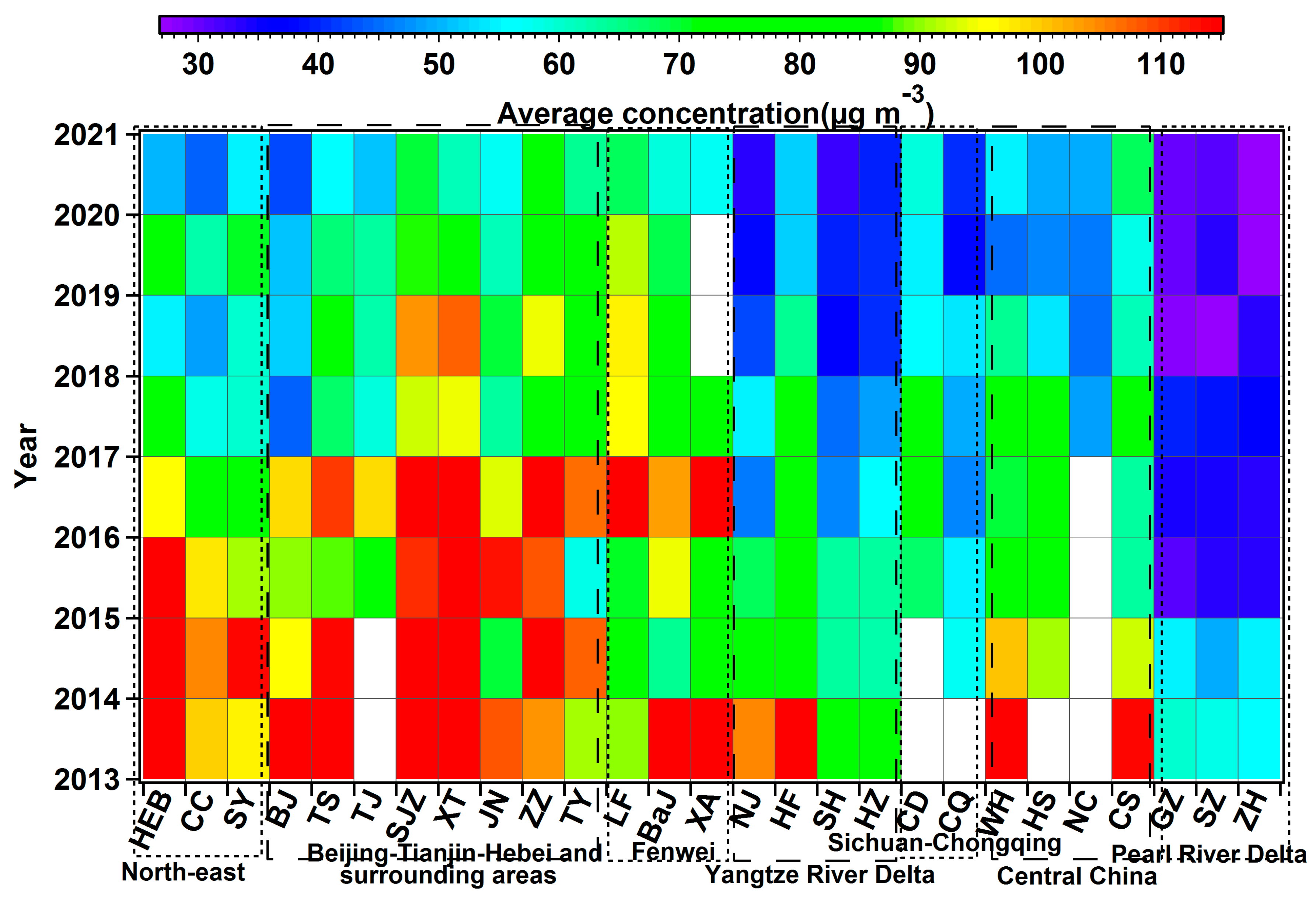
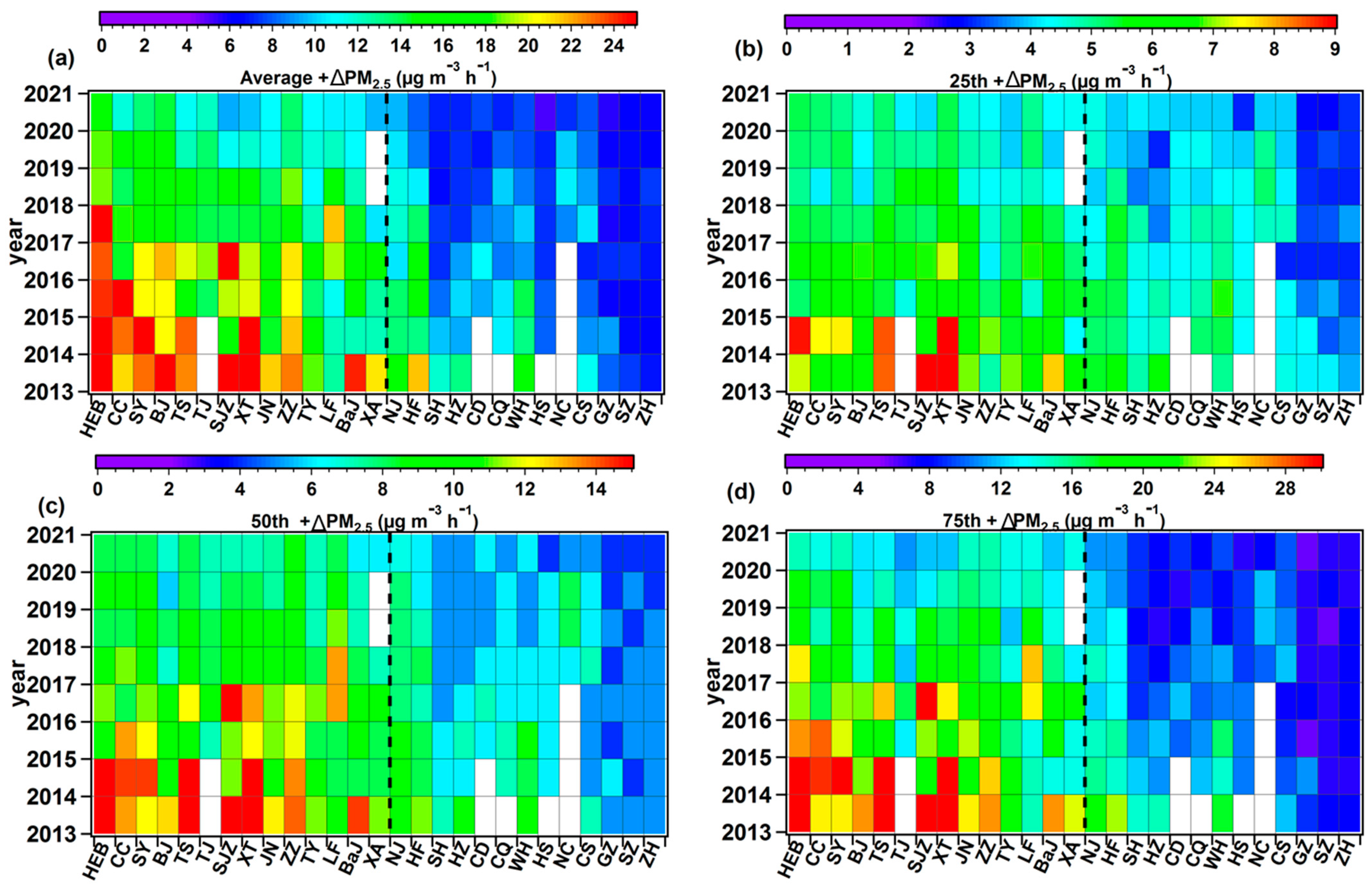
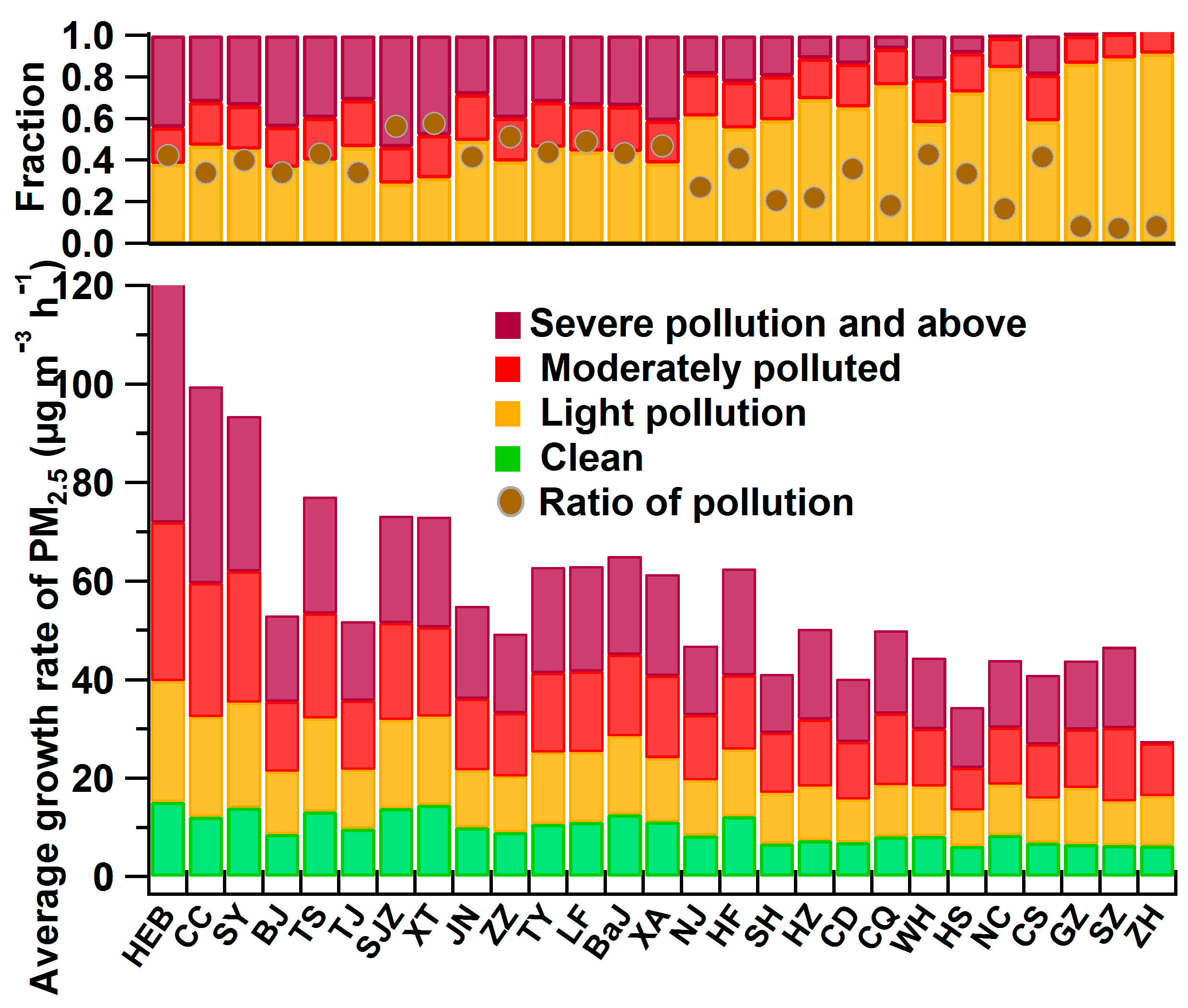
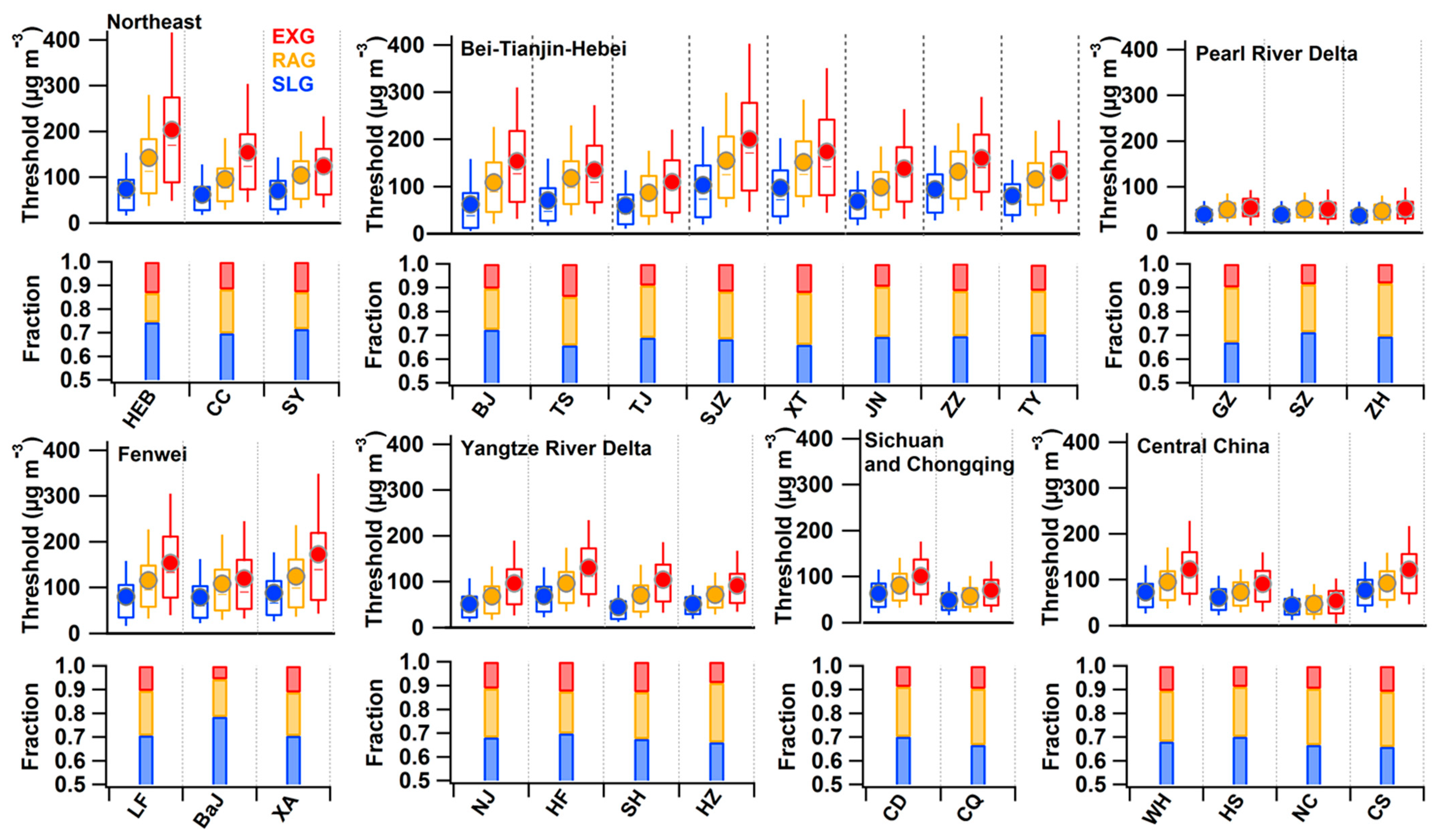
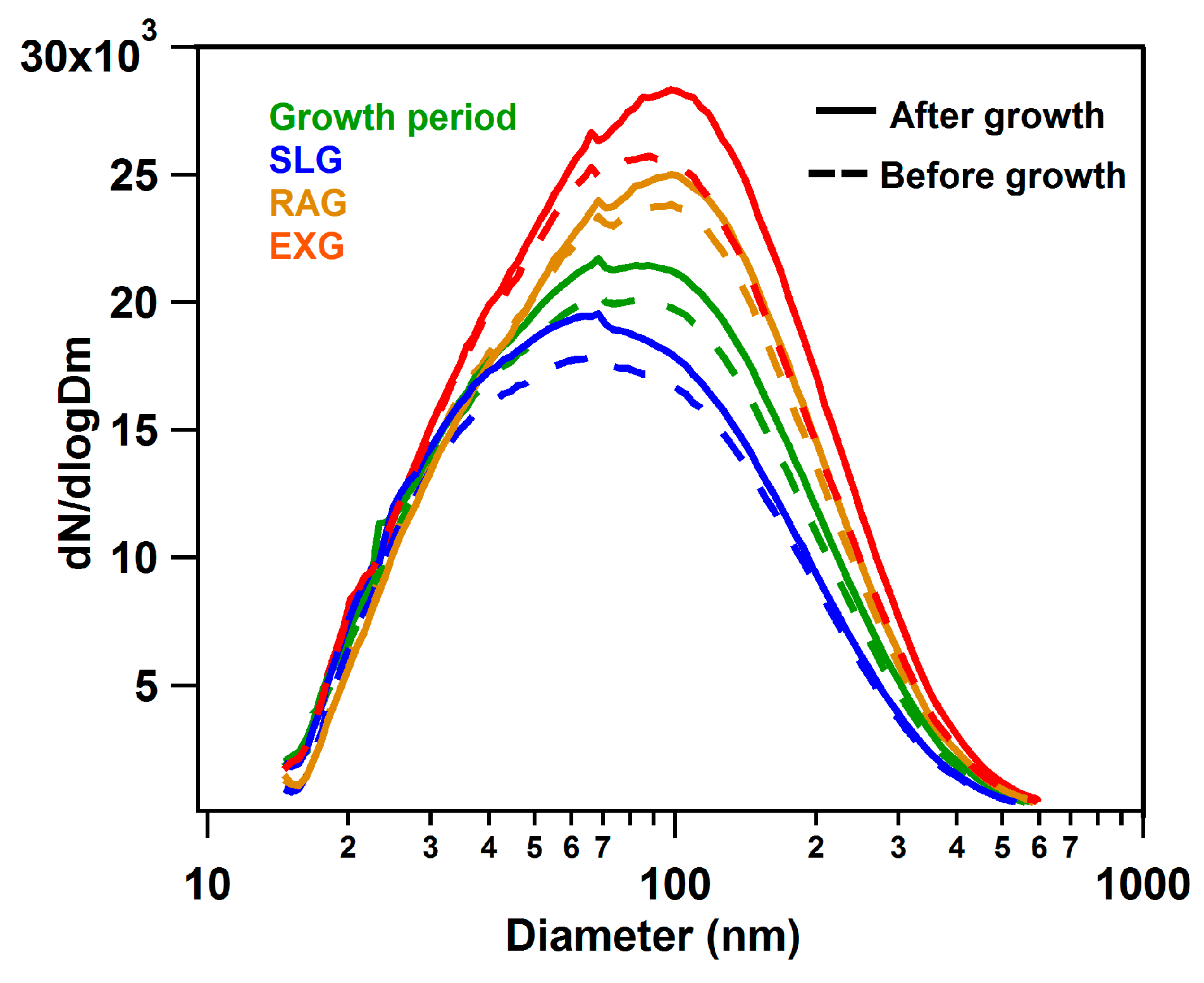

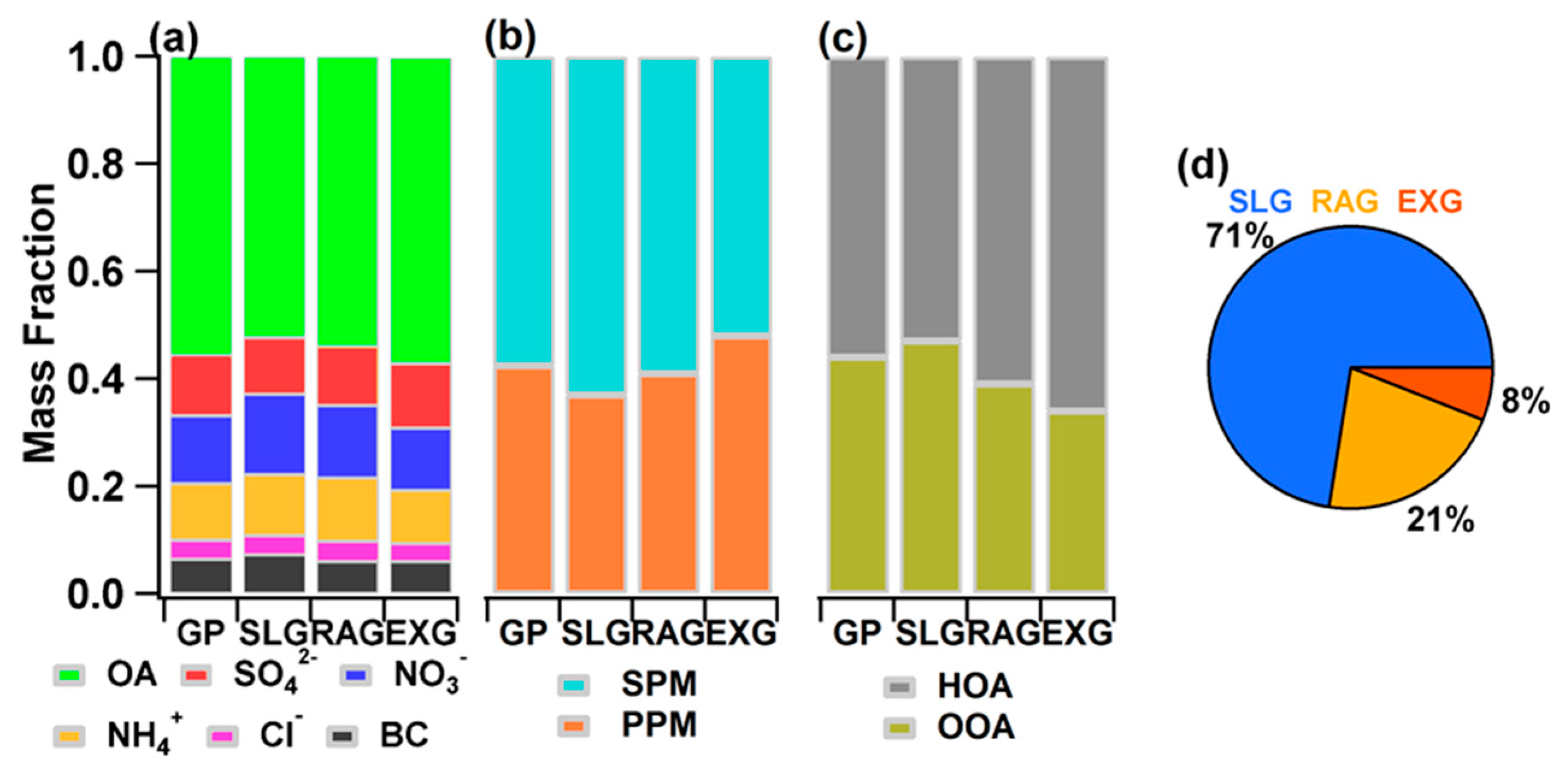


| Particle Size Mode | Before Growth/cm−3 | After Growth/cm−3 | Number of Samples | |
|---|---|---|---|---|
| SLG | Nucleation mode | 1241 | 2932 | 425 |
| Aitken mode | 9687 | 10,273 | ||
| Accumulation mode | 5529 | 5854 | ||
| RAG | Nucleation mode | 2190 | 3131 | 201 |
| Aitken mode | 11,696 | 13,760 | ||
| Accumulation mode | 7098 | 9838 | ||
| EXG | Nucleation mode | 3601 | 4269 | 115 |
| Aitken mode | 13,451 | 17,972 | ||
| Accumulation mode | 9252 | 13,735 |
Publisher’s Note: MDPI stays neutral with regard to jurisdictional claims in published maps and institutional affiliations. |
© 2022 by the authors. Licensee MDPI, Basel, Switzerland. This article is an open access article distributed under the terms and conditions of the Creative Commons Attribution (CC BY) license (https://creativecommons.org/licenses/by/4.0/).
Share and Cite
Jiang, Q.; Zhang, H.; Wang, F.; Wang, F. Research on the Growth Mechanism of PM2.5 in Central and Eastern China during Autumn and Winter from 2013–2020. Atmosphere 2022, 13, 134. https://doi.org/10.3390/atmos13010134
Jiang Q, Zhang H, Wang F, Wang F. Research on the Growth Mechanism of PM2.5 in Central and Eastern China during Autumn and Winter from 2013–2020. Atmosphere. 2022; 13(1):134. https://doi.org/10.3390/atmos13010134
Chicago/Turabian StyleJiang, Qi, Hengde Zhang, Fei Wang, and Fei Wang. 2022. "Research on the Growth Mechanism of PM2.5 in Central and Eastern China during Autumn and Winter from 2013–2020" Atmosphere 13, no. 1: 134. https://doi.org/10.3390/atmos13010134
APA StyleJiang, Q., Zhang, H., Wang, F., & Wang, F. (2022). Research on the Growth Mechanism of PM2.5 in Central and Eastern China during Autumn and Winter from 2013–2020. Atmosphere, 13(1), 134. https://doi.org/10.3390/atmos13010134






